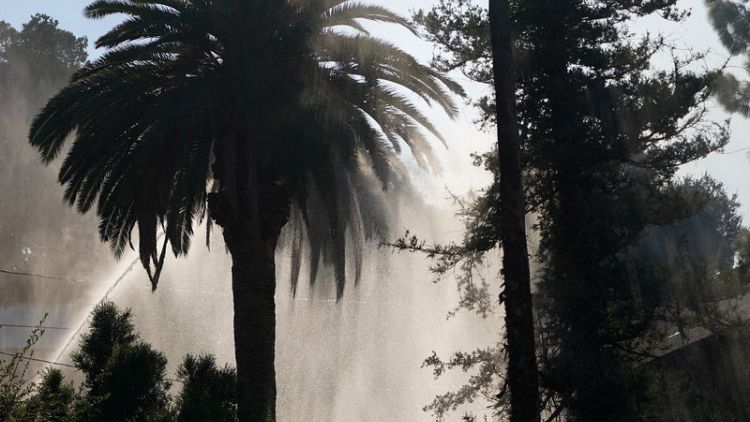By Omar Younis
SIMI VALLEY, Calif. (Reuters) - A fast-moving wildfire threatened thousands of homes and the Ronald Reagan Presidential Library outside Los Angeles on Wednesday as extraordinarily dry Santa Ana winds buffeted the region, forcing meteorologists to grasp for new language to warn of the danger.
The fire erupted in Ventura County's Simi Valley, about 30 miles (50 km) northwest of an earlier blaze that has been consuming the shrub-covered hills near the Getty Center museum in west Los Angeles since Monday, displacing thousands of residents from some of the city's priciest neighborhoods.
The Easy fire in Simi Valley quickly grew into the most consequential of several new blazes that sprang up around the region on Wednesday, prompting evacuations of an estimated 7,000 homes affecting about 26,000 people.
In Riverside County east of Los Angeles, a wind-driven brush fire swiftly charred 100 acres (40 hectares), forcing the evacuation of two mobile home parks, local fire officials said.
For firefighters, weather conditions could hardly be worse, with thick brush and chaparral left bone dry by lack of rain and low humidity, as fierce winds hurled flaming embers through the air to ignite spot fires ahead of advancing flames.
“The fire outflanked us very rapidly today, pushed by those 40- to 50-mile-per-hour winds," Ventura County Fire Department assistant chief Chad Cook told reporters. "We did experience gusts up to 65 miles per hour this morning, which made long-range spotting very, very dangerous.”
Cook said erratic, high winds also forced intermittent grounding of firefighting aircraft through the day.
The National Weather Service issued an unprecedented "extreme red flag" warning for wildfires in Los Angeles and Ventura counties ahead of two days of intense, dry wind gusts that were forecast to reach near-hurricane force.
"I don't know if I've ever seen us use this warning," said forecaster Marc Chenard. "It's pretty bad."
Statewide, the weather service issued alerts for "critical" or "extreme" fire hazards covering more than 34,000 square miles (88,000 square km), encompassing some 21 million people.
HELICOPTERS AND PLANE TANKERS
The Easy fire in Simi Valley ignited just before dawn off a road named Easy Street and grew to 1,300 acres (530 hectares) by late morning, fanned westward by Santa Ana winds.
One wall of flames raced across scrub-covered slopes at the edge of the hilltop Reagan Library, which houses the late president's archives and memorabilia, including the Air Force One jet on which he flew.
Pre-positioned strike teams of firefighters, backed by water-dropping helicopters and airplane tankers dumping payloads of fire retardant, swarmed the area as flames closed in on the library campus.
“We’re surrounded. It’s a scary situation. But I’m sure they’ll get on top of it,” John Heubusch, the library's executive director, said in an interview with KNX radio in Los Angeles. “It’s as close as it gets.”
By late morning, emergency crews had largely subdued flames, and the fire moved off in other directions.
"Fire moved around the perimeter of the Reagan Library, and we had successful stands up there on protecting the library and the infrastructure around the facility,” Cook said.
On numerous ranches nearby, residents in protective face masks scrambled to coax nervous horses and other livestock into trailers to drive them to safety.
The fire prompted public schools and at least three college campuses in the area to cancel classes for the day.
The Santa Ana winds are a regional weather phenomenon that sends gusts westward off the desert to the east, through mountain passes and out to the Southern California coast. They were forecast to reach sustained speeds of 50 to 70 mph hour (80 to 110 km per hour) on Wednesday and Thursday.
ELECTRIC HAZARDS, BLACKOUTS
Arson investigators say the Getty fire was likely caused by a broken tree branch blown into power lines during high winds on Monday morning. It spread, consuming 745 acres (300 hectares) by Wednesday morning, with about a quarter contained by firefighters. At least 12 homes have been destroyed.
Electricity remained cut off to hundreds of thousands of homes and businesses in northern and central California on Tuesday as a precaution by the state's largest utility, Pacific Gas and Electric Co, a unit of PG&E Corp <PCG.N>.
California Governor Gavin Newsom has accused PG&E of failing to adequately modernize and safely maintain its power systems.
In northern California, firefighters struggled for a sixth day against the 76,000-acre (30,760-hectare) Kincade fire in Sonoma County's wine country. High-wind forecasts prompted PG&E to impose a new round of blackouts for nearly 600,000 homes and business on Tuesday.
Utilities serving Southern California's more urban areas have imposed smaller-scale outages.
PG&E acknowledged last week that the Kincade fire started near a damaged PG&E transmission tower at about the time a live high-voltage line carried by that tower malfunctioned.
The company filed for bankruptcy in January, citing $30 billion in potential liability from a series of deadly fires sparked by its equipment in 2017 and 2018.
As many as 190,000 people were displaced at the height of evacuations from the Kincade fire, but authorities began allowing residents to return to their homes this week as firefighters gained a handle on the blaze.
Property losses from the Kincade, listed at 30% contained, were put at 189 homes and other structures, double Monday's tally.
(Reporting by Omar Younis in Simi Valley; Additional reporting by Steve Gorman, Alex Dobuzinskis and Dan Whitcomb in Culver City, California, Jonathan Allen in New York, Andrew Hay in New Mexico and Rich McKay in Atlanta; Editing by Bill Tarrant, Jonathan Oatis and Leslie Adler)
